How to Make Sauerkraut in a Crock: Choosing the Best Crock
How to make sauerkraut in a crock starts with making sure you have a good crock! Here’s a guide to help you select a good fermentation crock, whether you’re buying new or thrifting:
- Lead-Free Ceramic Glaze: Ensure the crock is made with lead-free ceramic glaze. Lead can leach into food and pose health risks, so it’s crucial to use a safe, non-toxic glaze.
- Size Options: Select a crock size that suits your fermentation needs. Common sizes range from 1 to 5 gallons. A smaller crock (1-2 gallons) is ideal for fermenting batches for families with 2-4 people. A larger crock (3-5 gallons) is better for bigger families and sharing your sauerkraut with friends. Sauerkraut stores well in the fridge, so no matter which size you choose, transferring it to jars to store in the refrigerator is a great option.
- Condition and Seals: When thrifting old crocks, check for cracks or chips, as these can affect the fermentation process. Cracks and chips can harbor unwanted microorganisms in the porous ceramic and mess up fermentation.
- Shape and Design: A traditional fermenting crock typically has a wide mouth and fitted heavy weights to help keep vegetables submerged. The shape should allow easy packing and weight distribution to ensure even fermentation.
By paying attention to these factors, you can find a ceramic crock that will provide a reliable and effective fermentation environment for your sauerkraut. Click here to purchase a 2-gallon crock exactly like mine from Haselmayer Goods.
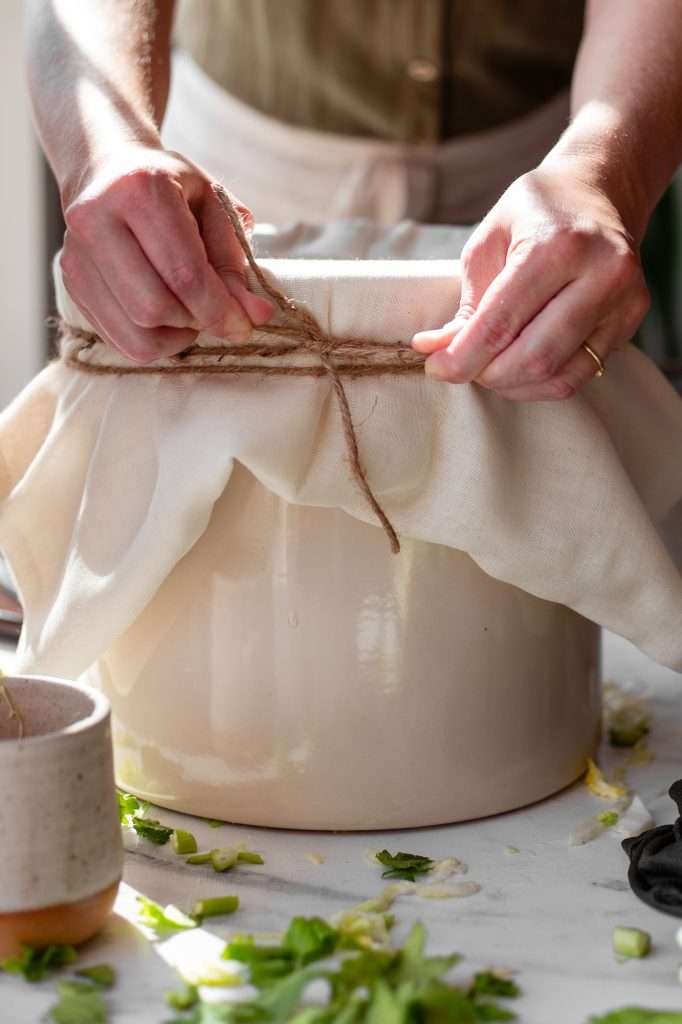
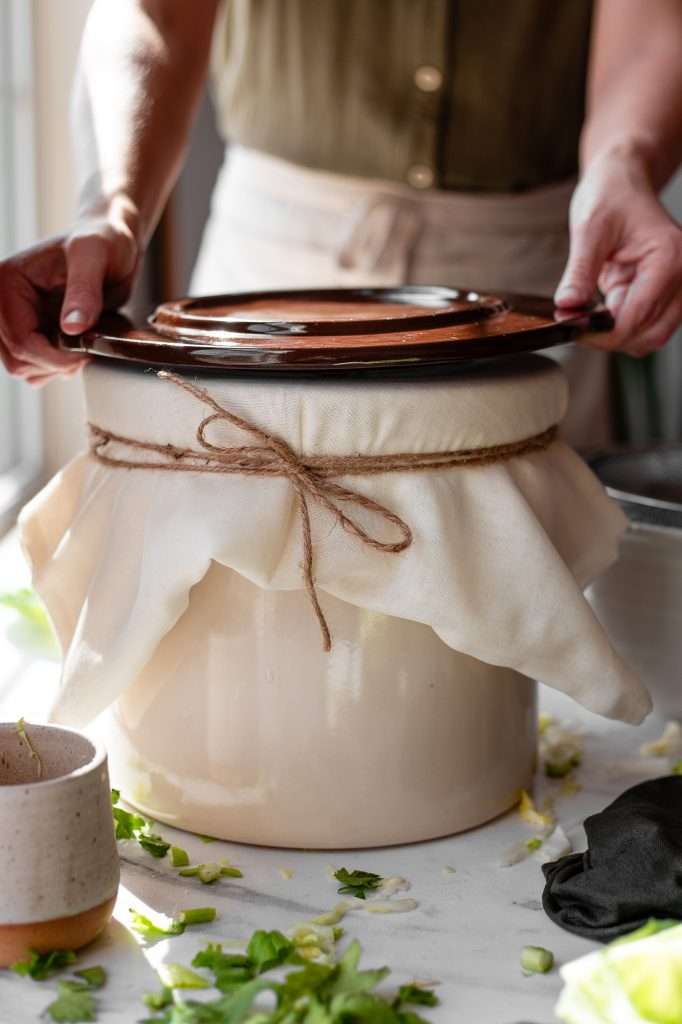
Ceramic fermentation crocks come with two primary types of lids:
The first type is the water-sealing lid, which features a rim that fits into a water-filled channel. This design creates an airtight seal, preventing oxygen from entering and ensuring that carbon dioxide can escape. This setup can help maintain an anaerobic environment at the brine air interface. Generally, this type of lid is not necessary. If everything, including the fermentation weight, stays submerged, you’ll have an anaerobic environment below the brine, and that’s what matters.
The second type is the flat lid, which rests directly on the top of the crock. While it doesn’t create a water seal, it keeps contaminants out, prevents evaporation, and maintains a stable fermentation environment. This is the type of lid I have. With it, I also use a tight weave cloth to prevent fruit flies from getting in. You can secure the fabric under the lid or over it, whichever you prefer. The key is not to overfill the crock, or the fabric will get wet with brine.
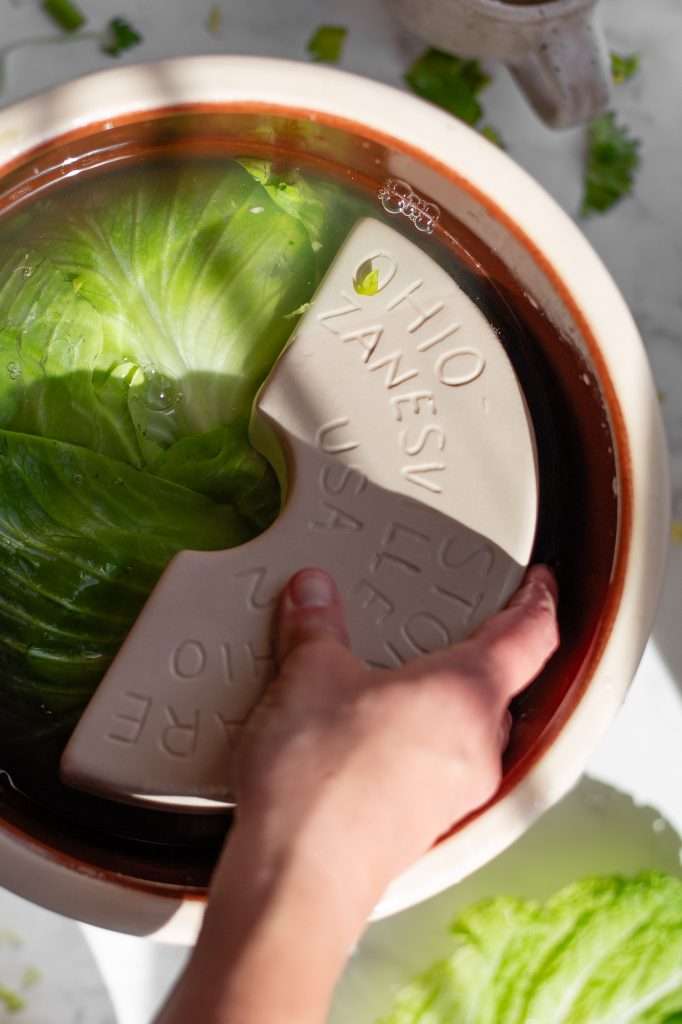
Ceramic Fermentation Crock Weights
While you can use various things for weights when fermenting large batches of sauerkraut, it is best to use an unglazed ceramic weight fit to your crock for best results. These weights are designed to be dense and heavy enough to submerge the large volume of cabbage. Here are links to weights for the most common crock sizes:
To clean and prepare the weight, especially if thrifted, soak it in high-salinity salt water (10%) overnight, then rinse with hot water before use. If you buy a crock where I got mine from, Haselmayer Goods, it comes with a weight.
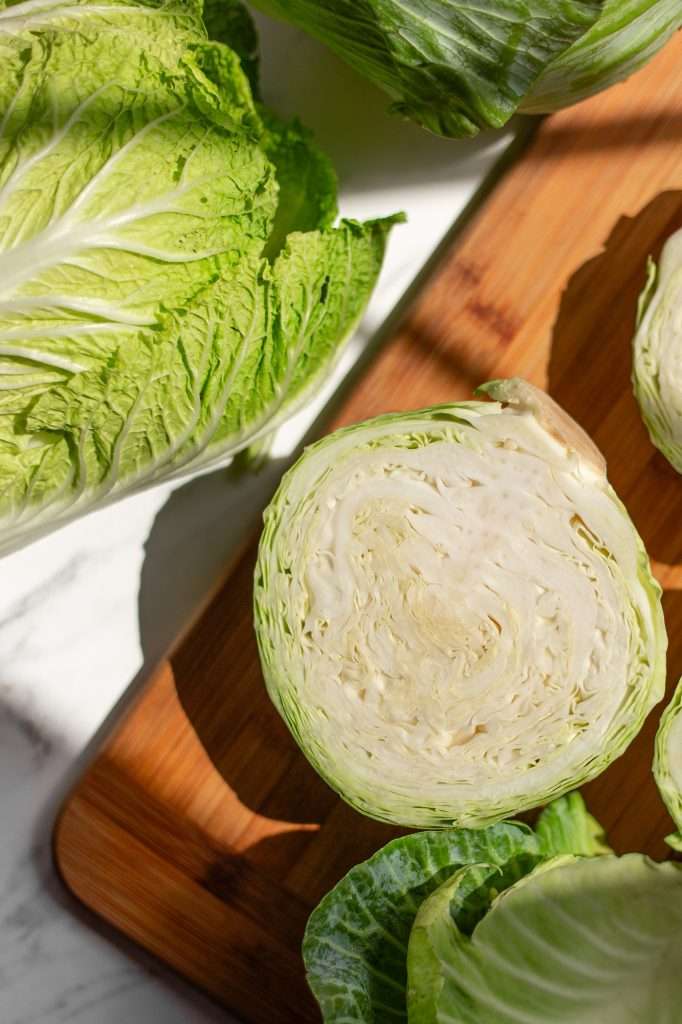
How to Make Sauerkraut in a Crock: Choosing the Best Cabbage
I always suggest starting with one (or a mix) of my three favorite cabbages when learning how to make sauerkraut in a crock.
- Green Cabbage:
- Texture: Crisp and sturdy leaves hold up well during fermentation.
- Flavor: Mild and slightly sweet, providing a balanced taste in sauerkraut.
- Availability: It is widely available, affordable, and easy to grow at home, making it a popular choice for home fermenters.
- Napa Cabbage:
- Texture: Tender and more delicate leaves that ferment quickly, resulting in a softer sauerkraut.
- Flavor: Mild and slightly sweeter than green cabbage, adding a unique, subtle flavor.
- Versatility: Often used in Asian-inspired recipes, bringing a different dimension to traditional sauerkraut.
- Savoy Cabbage:
- Texture: Slightly crinkled leaves with a tender texture that works well for a more nuanced sauerkraut.
- Flavor: Mild and slightly earthy, with a complex taste profile that can enhance the depth of the sauerkraut.
- Appearance: Attractive, textured leaves add visual appeal and variety to your fermented creations.
Each of these cabbages brings distinct qualities to sauerkraut, allowing you to experiment with different flavors and textures while still achieving consistent results. Be sure to harvest or purchase cabbages with lovely outer leaves and save the outer leaves. You’ll use these to secure all the shredded cabbage under the fermentation weight.

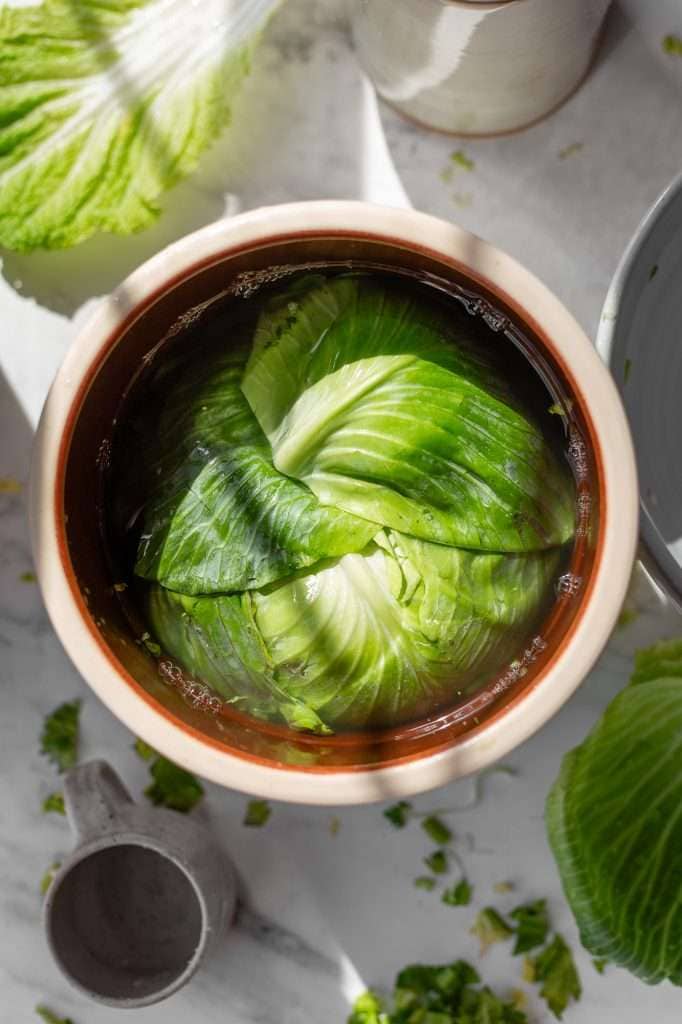
How many pounds of cabbage do you need for a 5-gallon crock? (and the other sizes too?)
Here is my master list of how much cabbage you’ll need for different crock sizes. These amounts assume you will be adding 20% other vegetables or fruit (see paragraph below this one). They are also rounded up a bit from the recipes to account for discarding the cabbage cores.
- 1-Gallon Crock:
- Cabbage Needed: 1,800 grams (about 4 pounds)
- 2-Gallon Crock:
- Cabbage Needed: 3,600 grams (about 8 pounds)
- 3-Gallon Crock:
- Cabbage Needed: 5,400 grams (about 12 pounds)
- 5-Gallon Crock:
- Cabbage Needed: 9,000 grams (about 20 pounds)

How to Make Sauerkraut in a Crock—Recipe Composition and Variations
When making sauerkraut, it’s essential to get the right balance of ingredients to ensure proper fermentation and flavor. Here’s a simple way to understand the composition of making sauerkraut in a crock.
The Ideal Composition of Ingredients:
- Cabbage: 65% of the total weight
- Water: 15% of the total weight
- Veg/Fruit Addition 1: 10% of the total weight
- Veg/Fruit Addition 2: 10% of the total weight
- Add 2.5% salt to the total mixture
Veg/fruit additions 1 and 2 are your opportunity to customize the recipe! Choose any veg or fruit you want to add in. I have a list of all my favorite sauerkraut add-ins in the blog section below, so check that out if you need ideas.
If you want to make plain sauerkraut, add more cabbage as your veg/fruit 1 and 2.
You can add a moderate amount of dry spices without changing the recipe.
Using this ideal composition of ingredients, I’ve created a list of master recipes for each crock size, so no matter which size you have, you can quickly learn how to make sauerkraut in a crock:
1-Gallon Crock
- Total Weight (without salt): 2,750 grams
- Cabbage (65%): 1,787.5 grams
- Water (15%): 412.5 grams
- Veg/Fruit Addition 1 (10%): 275 grams
- Veg/Fruit Addition 2 (10%): 275 grams
- Salt (2.5% of total weight): 2,750 grams x 0.025 = 68.75 grams
2-Gallon Crock
- Total Weight (without salt): 5,500 grams
- Cabbage (65%): 3,575 grams
- Water (15%): 825 grams
- Veg/Fruit Addition 1 (10%): 550 grams
- Veg/Fruit Addition 2 (10%): 550 grams
- Salt (2.5% of total weight): 5,500 grams x 0.025 = 137.5 grams
3-Gallon Crock
- Total Weight (without salt): 8,250 grams
- Cabbage (65%): 5,362.5 grams
- Water (15%): 1,237.5 grams
- Veg/Fruit Addition 1 (10%): 825 grams
- Veg/Fruit Addition 2 (10%): 825 grams
- Salt (2.5% of total weight): 8,250 grams x 0.025 = 206.25 grams
5-Gallon Crock
- Total Weight (without salt): 13,750 grams
- Cabbage (65%): 8,937.5 grams
- Water (15%): 2,062.5 grams
- Veg/Fruit Addition 1 (10%): 1,375 grams
- Veg/Fruit Addition 2 (10%): 1,375 grams
- Salt (2.5% of total weight): 13,750 grams x 0.025 = 343.75 grams
For any other crock size variations, use one of the recipes above and double it. For example, if you have a 4-gallon crock, double the 2-gallon recipe. If you have a 6-gallon crock, double the 3-gallon recipe.
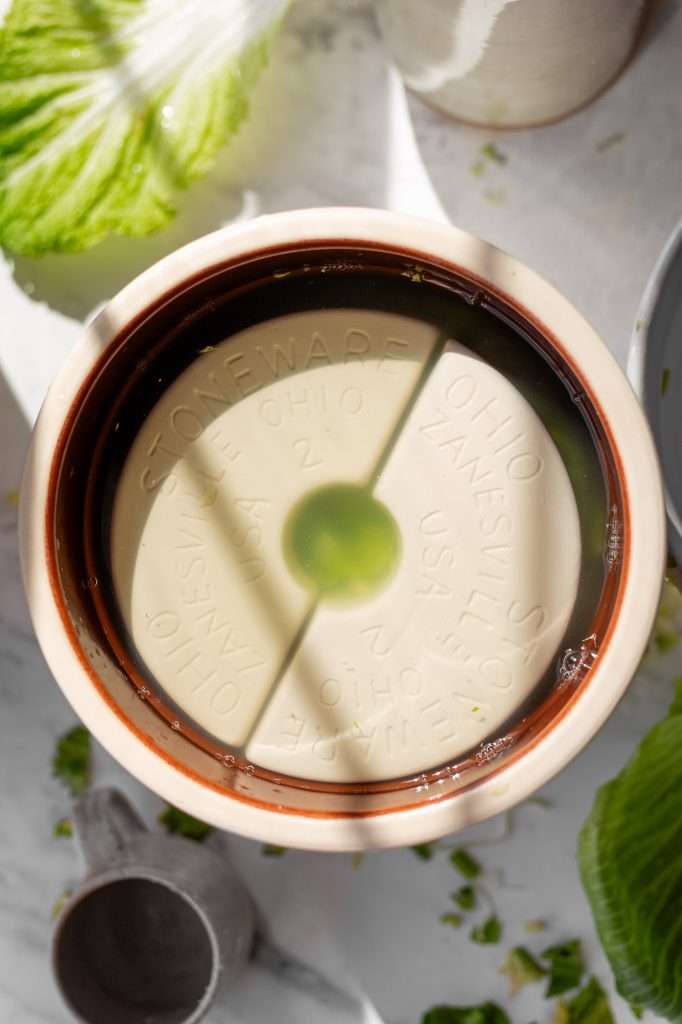
My favorite add-ins when making sauerkraut in a crock
The best part of learning how to make sauerkraut in a crock with my master recipe is the customization! You get to choose two vegetables or fruits to make up 20% of the sauerkraut. Don’t forget, if you want to make plain sauerkraut, add more cabbage as your veg/fruit 1 and 2. Also, you can add a moderate amount of dry spices without changing the recipe.
Here are some of my favorite combinations:
- Leek and Celery
- Apple and Celery
- Garlic and Jalapeno
- Carrot and Golden Beet
- Radish and Leek
- Carrot and Green Onions
- Bok Choy and Bell Pepper
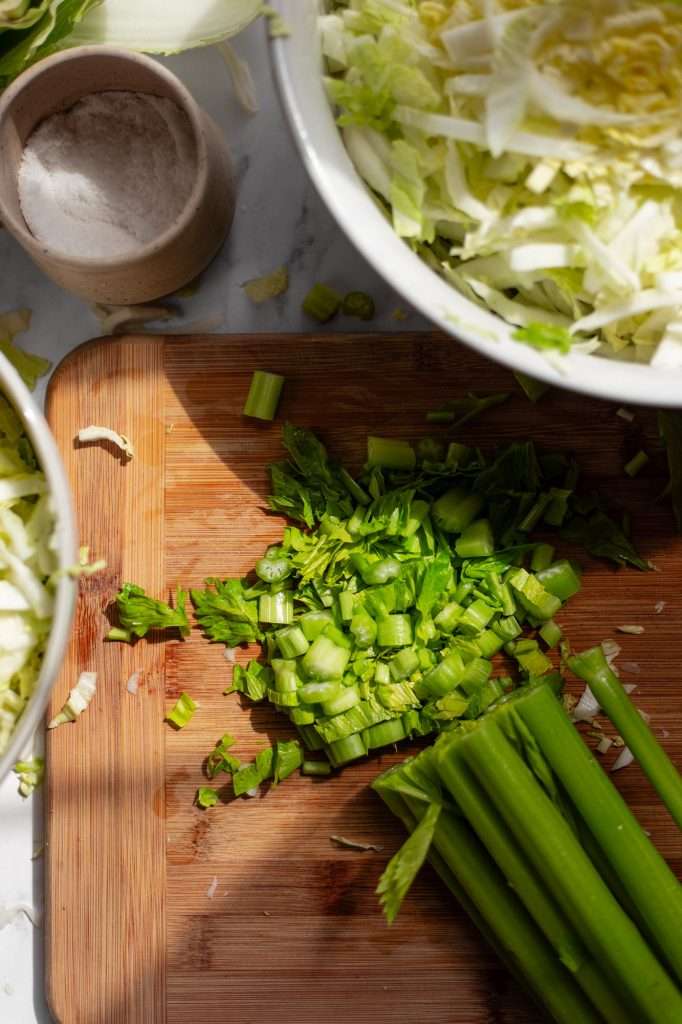
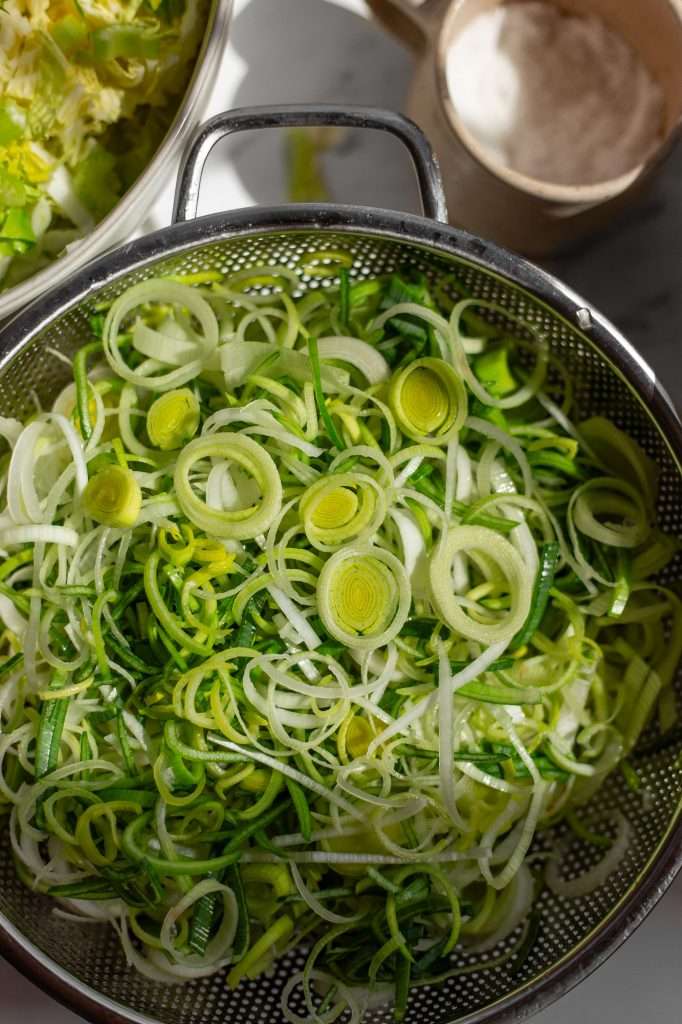
How to Make Sauerkraut in a Crock FAQ
What is the Ratio of Salt to Cabbage for Sauerkraut?
When learning how to make sauerkraut in a crock, salt concentration is the most essential part. The ideal ratio of salt for sauerkraut is 2.5% added to the total of all water-containing ingredients (or 2.44% total salt concentration). For reference, this is about 1% less salty than seawater.
Example Breakdown for a 2-Gallon Crock:
- Total Weight (without salt): 5,500 grams
- The Ingredient Breakdown:
- Cabbage: 65% of 5,500 grams = 3,575 grams of cabbage
- Water: 15% of 5,500 grams = 825 grams of water
- Veg/Fruit Addition 1: 10% of 5,500 grams = 550 grams of celery
- Veg/Fruit Addition 2: 10% of 5,500 grams = 550 grams of leeks
- Salt: 2.5% of 5,500 grams = 137.5 grams
- The Ingredient Breakdown:
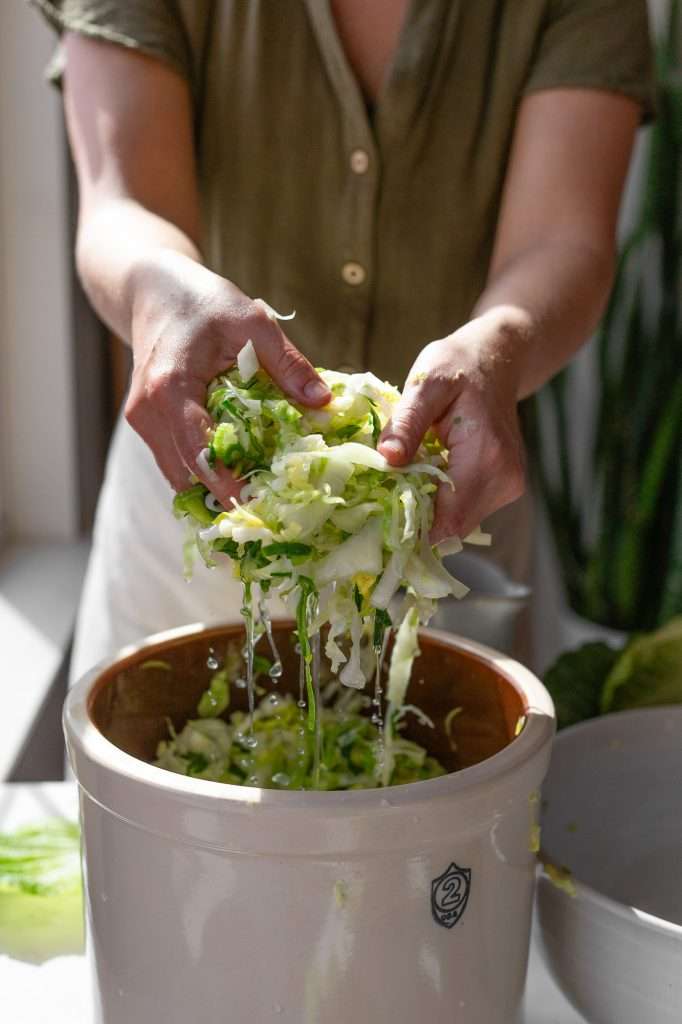
How do you know when sauerkraut is ready?
You will know your sauerkraut is ready when:
- There are no more bubbles
- The brine is cloudy (but there’s no mold growth or anything on the surface of the brine)
- The cabbage has turned to a muted green color
- It smells pleasantly sour; there are no gaseous or soapy smells
- It tastes salty, savory, sour, and delicious
How long can you leave sauerkraut in a crock?
You can transfer your sauerkraut to jars for refrigeration and begin eating it after 21-28 days of fermentation at room temperature in the crock.
Why is my Sauerkraut Mushy?
Sauerkraut turns mushy from pounding and massaging the chopped cabbage too much. This is why my sauerkraut recipes call for the addition of water. I do not like mushy sauerkraut, so adding water means I do not need to excessively pound and massage it to release the juices.
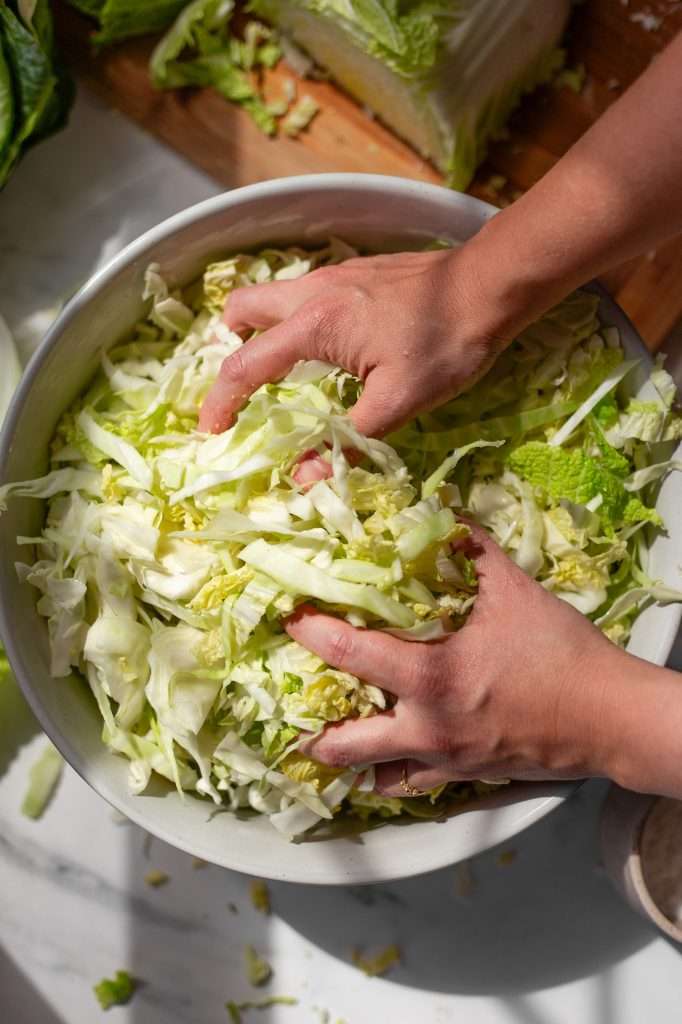
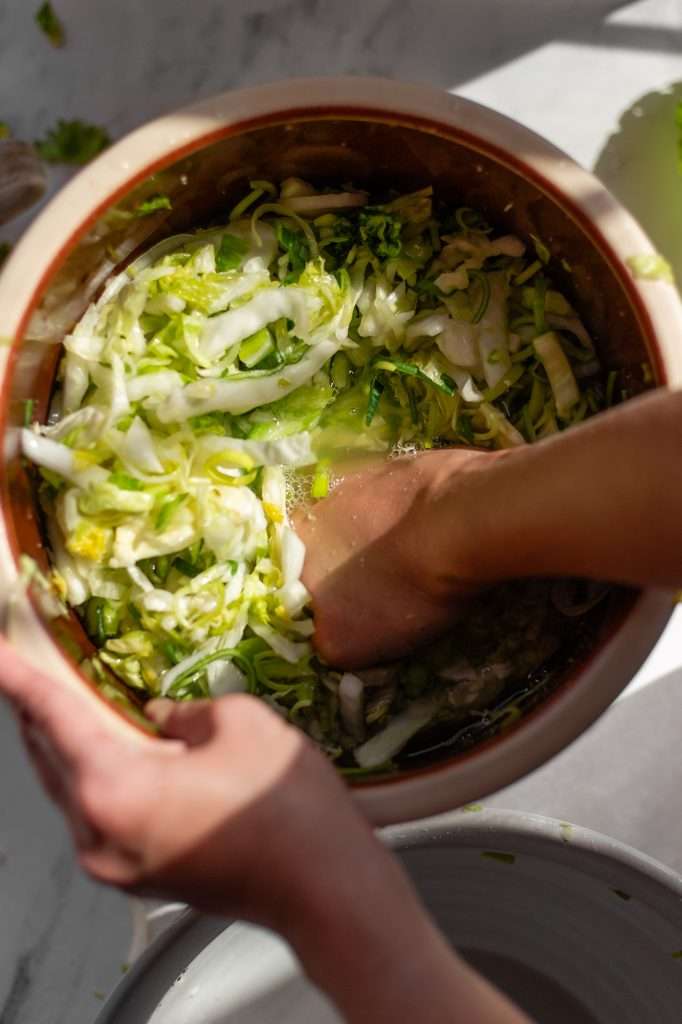
What do I do while it ferments for 21 days?
- Open up the crock once a day to:
- Make sure everything stays submerged
- Ensure the sides and lid are clean; give the lid a rinse if necessary
- Press down on the fermentation weight with your clean hands to release the gasses from the cabbage shreds
- If using a crock with a flat lid:
- Secure a tight-weave cloth under or over the flat lid with a rubber band or twine to prevent fruit flies
- You should probably secure a tight-weave fabric cloth over a water-sealing crock lid too.
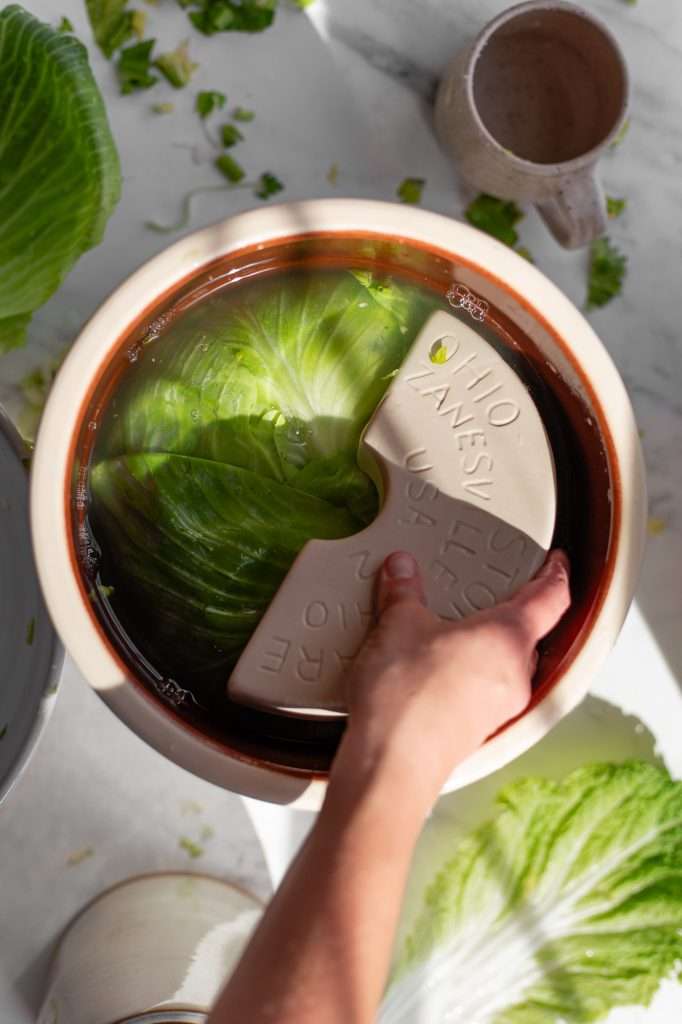

How to Make Sauerkraut in a Crock Customizable Master Recipe
Learn how to make sauerkraut in a crock with our comprehensive master recipe. This step-by-step guide teaches you how to choose a crock, the best cabbages for fermenting sauerkraut, the best salt ratio for making sauerkraut in a crock, and our customizable master recipes for any gallon size fermentation crock. Make traditional sauerkraut or mix in other fruits and vegetables.
- Prep: 45 mintues
- Total Time: 45 minutes
Ingredients
2-Gallon Crock Recipe (see notes for other volumes)
- 3,575 grams cabbage
- 825 grams water
- 550 grams leeks, chopped*
- 550 grams celery, chopped*
- 138 grams sea salt
- outer cabbage leaves
Equipment
- Lead-free Ceramic Crock
- Crock lid
- Ceramic Crock Weight
- Tight weave cloth
- rubber band or twine
- Kitchen scale
- Large mixing bowls
- Knife
- Cutting Board
- Colander
Instructions
- Wash all of your equipment well. Wash your crock, lid, and weights with natural soap and hot water. Rise all the soap away, then rinse with distilled white vinegar. For new or thrifted weights, wash with hot water and soap, then soak the unglazed ceramic weights in 10% salt water for a few hours.
- Remove the outer cabbage leaves, keeping them as intact as possible. Rinse them with cool water and set aside.
- Rinse the cabbage and other vegetables.
- Using a kitchen scale, weigh out the designated amounts of cabbage, leeks, and celery in grams. I like to quarter the cabbages and weigh them in chunks before chopping them into shreds.
- Chop your cabbage, leeks, and celery (or whatever vegetables/fruit you’re adding in). If using leeks, rinse them in a colander after chopping since they can hold dirt.
- In a separate small bowl, weigh the designated amount of sea salt.
- In a pitcher or large mason jar, measure out the water.
- Dissolve about half the sea salt in the water and set the other half aside.
- Place your crock near where you plan to store it for the duration of fermentation. Once full, it will be very heavy and difficult to move.
- Layer some chopped cabbage, leeks, celery, and a little bit of sea salt into the crock. Toss it around to mix in the salt as you go, and tamper it down with your fist. Keep layering, mixing, and tampering until you’ve added all the salt and vegetables.
- Wipe the sides with your hands to make sure no vegetable pieces are stuck to the sides. There should be a good bit of headspace in the crock. You need this headspace to allow room for the weights and brine release.
- Take the reserved outer cabbage leaves and tuck everything in. Tuck the cabbage leaves over the top and around the sides, securing all the cabbage shreds under the large leaves.
- Place the weight onto the leaves.
- Pour the salt water over the top.
- Place the lid and tight weave cloth on the crock. You can secure the tight-weave cloth under the lid or over it with twine or a rubber band, but you need this to prevent fruit flies from getting in.
- Allow the sauerkraut to ferment in the crock at room temperature for 21-28 days.
- Open the crock once a day to check and make sure the sides and lid are clean, and everything is submerged. If necessary, press down on the weight with clean hands to release the gases.
- After fermentation at room temperature for 21-28 days, remove the weight and the outer leaves. Pack the sauerkraut into jars, top with brine, and store in the refrigerator.
Notes
1-Gallon Crock
- 1,788 grams cabbage
- 412 grams water
- 275 grams leeks, chopped
- 275 grams celery chopped
- 69 grams sea salt
3-Gallon Crock
- 5,363 grams cabbage
- 1,237 grams water
- 825 grams leeks, chopped
- 825 grams celery, chopped
- 206 grams sea salt
5-Gallon Crock
- 8,938 grams cabbage
- 2,062 grams water
- 1,375 grams leeks, chopped
- 1,375 grams celery, chopped
- 344 grams sea salt
For any other crock size variations use one of the recipes above and double it. For example, if you have a 4-gallon crock, double the 2-gallon recipe. If you have a 6-gallon crock, double the 3-gallon recipe.
I used leeks and celery in this recipe, but you can use any fruit or vegetable instead, just keep the amounts the same.















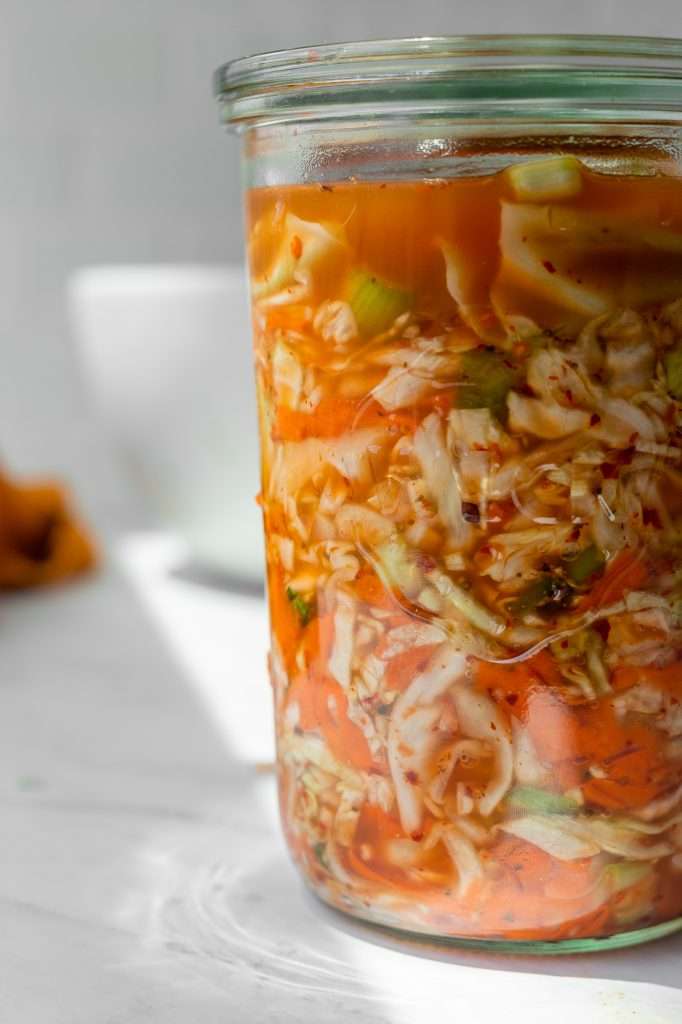
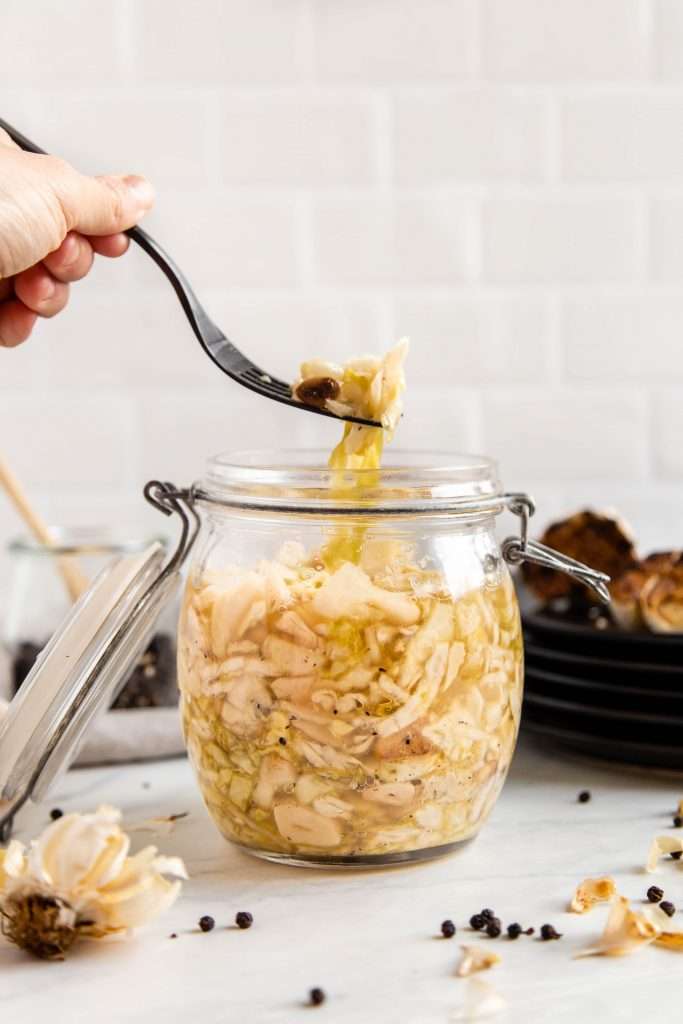





I cant wait to buy my crock!!! Thank you so much for all the incredible information! I am so excited to try, especially with the leeks and apples. I do have a question about after fermentation though. How long will it last in the fridge? Can I freeze it or can it? Thank you again.
It lasts so long! You can keep it in the fridge for 2 years, probably longer, but I expect you’ll eat it all before then
This looks so good! Def gonna make it!
One question; what salt do you use? Regular sea salt?
yes! regular sea salt. Any salt works, just make sure it has no anti-caking agents and no iodine added.
Hi! Just found your site and think it is great! I am making a Salvadoran fermented curtido, which calls for 1/2 a large onion and a couple hot peppers, in addition to 3 carrots – the base is 1/2 head of cabbage. I am ending up with about 700 gr of which about 150 to 200 is onion – do I need to adjust the salt above 2.5%?
2.5% total salt should still work great since it’s mostly cabbage.
Hi 👋 I have a question. I am making sauerkraut using leftover shredded cabbage with red onion and cilantro from a Mexican meal. I now realize it may have been lightly tossed in olive oil. Will this affect the fermentation process? It’s in the jar and looks fine so far. Thank you!
yes, it will influence the fermentation process and it’s not okay. I do not advise eating that. You should follow the recipes here as written.
Hello Kaitlynn,
If, during the fermentation process, there ends up being a lack of liquid, can I add water? And if so, is it possible to simply add boiled and cooled water, or should I use a mixture of water and salt (2.5%)?
Also, if I add a salted water mixture, I will inevitably increase the total salt percentage…
Thank you for all your recipes!
Thank you for your question, and I’m so glad you’re enjoying the recipes!
There shouldn’t be a lack of brine in this recipe. If your cabbage rises above the brine level once fermentation has started, simply open the jar, remove the weight, press the cabbage down with clean hands or a clean utensil, and then replace the weight and lid.
It’s best not to add water once fermentation has started, whether it’s salted or not, as this will raise the pH and affect the fermentation process.
As for adding a salted water mixture, if you add a 2.5% salt brine to an existing 2.5% total salt mixture, the salt concentration will stay the same. You can definitely add more 2.5% brine when you first mix everything together if you want a ton of brine. But again, I do not recommend adding anything once fermentation has started.
Hope that helps!
Thank you for the answer!
I was also wondering if you think it would be possible to seal the sauerkraut in Mason jars by boiling it before putting it in the jars, of course. Would the pH be suitable for sealed preservation? I’m asking because it would make storage easier.”
The pH should be suitable, but I’m not sure how canning it will go overall because I haven’t tested that process. If you want to experiment, I think you’d need to cook it all and then follow a tested sauerkraut canning method.
I’ve started my second v batch, the first didn’t turn out as planned. But I was wondering. I just opened my crock up after a couple days abd found a couple tiny blue mold spots on the top of my weight. Not touching the cabbage at all, I carefully removed the one, wasted it off-poured a bit of white vinegar and then boiling water over it to disinfect. Should I throw the whole batch?
Anything with mold is a see what happens and proceed at your own risk situation. Since I can’t see it or test it, I can’t tell you for sure! Are you using a brand new crock? and are you making sure the weight is also staying submerged or was it peeking up out of the brine?
I tried this recipe and had issues with mold growing on the top of the cabbage leaves I put on top. What should I do next time to avoid this situation?
This sounds like the cabbage leaves did not remain submerged. Were you using a fermentation weight and checking it regularly to make sure everything was staying submerged? (step 17)
Thank you for all the details. It’s difficult to find a source that goes into detail like you do.
you’re welcome! I’m glad you’re finding the details helpful!